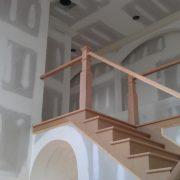Differences Between Drywall and Concrete for Shower Walls
A common question is whether drywall is a good choice for tiling near a shower. It’s not, and for several good reasons. However, concrete slabs which are a durable alternative suitable for shower walls, unfortunately are difficult to cut and handle. The price of the material and the extra demand for labor, however, are worth the extra time and money.
Humidity
Cement boards are made with cement and composites, which gives them excellent water resistant properties. In contrast, traditional gypsum panels absorb water and decompose. Over time, the water drywall attracts will accumulate mold and mildew. Even if you seal the walls with the shower tiles, moisture will find a way into the drywall, especially at the base, where the material acts as a sponge, soaking up moisture from the wall.
Variety drywall
Companies produce mildew and moisture resistant drywall called green panels for moisture-prone areas. These panels are named for the green paper resistant to moisture that covers them. This type of drywall is appropriate for a locker room or bathroom (where wet conditions exist), but cannot withstand prolonged and direct contact with water in your shower. Even green panels deteriorate in a shower over time; green lining paper is moisture resistant but not waterproof.
Proper use of drywall in the shower
There is an exception that allows the use of drywall in a shower: the flotation process. Green panels serve as the basis for floating walls, which consist of a first layer of plastic or paper, followed by a wire mesh and mortar mixture of cement and lime. Some experienced tile installers prefer to have a plaster base to float, while others believe that the ideal is to mesh and float on the beams. Either way, the green panels are a good basis for the floating wall, but just because they are sealed with a paper or plastic moisture barrier.
Installing concrete slabs
Producers of cement board require the installation of a plastic sheet 4 mm (unit describing the material thickness), or paper water resistant construction as a repellent barrier to moisture under the cement board. You can take things a step further by applying a waterproof film on the surface of the concrete slabs and tiles placed on the film. Several companies produce suitable films for this application.






